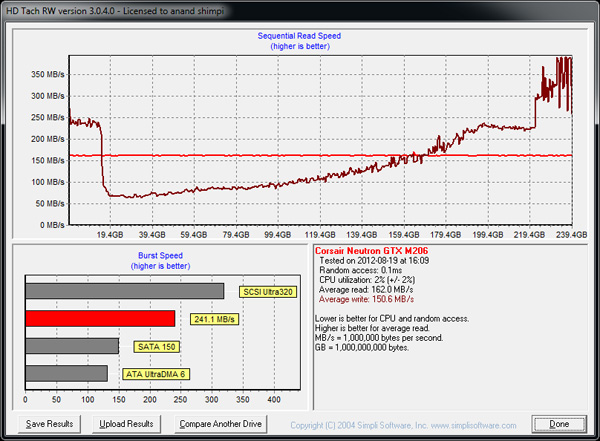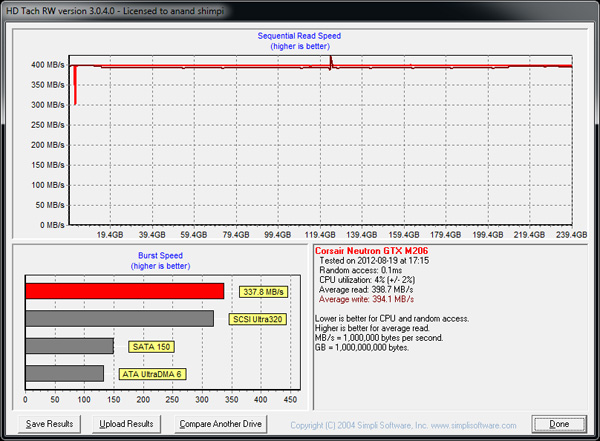Corsair Neutron GTX SSD Review (240GB): Link A Media Controller Tested
by Anand Lal Shimpi on August 20, 2012 6:00 AM EST- Posted in
- Storage
- SSDs
- Corsair
- Neutron
- Link a Media
Performance Over Time & TRIM
Over time SSDs can get into a fairly fragmented state, with pages distributed randomly all over the LBA range. TRIM and the naturally sequential nature of much client IO can help clean this up by forcing blocks to be recycled and as a result become less fragmented. Leaving as much free space as possible on your drive helps keep performance high (20% is a good number to shoot for), but it's always good to see how bad things can get before the GC/TRIM routines have a chance to operate. As always I filled all user addressible LBAs with data, wrote enough random data to the drive to fill the spare area and then some, then ran a single HD Tach pass to visualize how slow things got:
Performance drops pretty low but it's not terrible at above 50MB/s. The flat line around 230MB/s both at the starting and higher LBAs is a bit peculiar, but we could just be seeing some pinning of data that the controller thinks is important for whatever reason. Read performance is also pretty heavily impacted, being cut in more than half once the drive is in this state. A quick format of the drive triggers TRIM which restores performance to new:
The Neutron GTX is reasonably resilient but behaves like a normal SSD in that if you throw a lot of random writes at it, you will see steady state performance well below 100MB/s. Most client usage models, particularly if you leave enough free space on the drive (I like to shoot for ~20% free space), shouldn't get into this state even after years of use.












36 Comments
View All Comments
wsjudd - Monday, August 20, 2012 - link
Looks like there's a stray bit of punctuation in here:"The drive is the Neutron, and the controller maker? Link A Media Devices"
AnotherGuy - Monday, August 20, 2012 - link
Really after so much information in the article... thats what you have to say... the Punctuation?I am afraid people wanna see some relevant thoughts and opinions about the info on the article not ur stupid comments on punctuation. These articles are about technology not your English 101 u take at school.
Really tired of the same comments on almost every article.
gmallen - Monday, August 20, 2012 - link
They certainly don't want to see inane, off-topic troll-bait like your comment. If you're so distressed by these comments, don't read them or comment about them. Get a life instead.AnotherGuy - Monday, August 20, 2012 - link
when he or others who post same comments see my insane comment, they might realize that they are actually annoying and stop doing it.Mr. Pedantic - Monday, August 20, 2012 - link
We can only hope you will recognise the same thing and stop posting useless rubbish.seapeople - Monday, August 20, 2012 - link
Not to feed the trolls, but I agree with this troll somewhat. The proposed punctuation correction wasn't even necessarily correct.Rishi100 - Monday, August 20, 2012 - link
Let it be so.... attractive, that I jump on my second SSD.Bmadd89 - Monday, August 20, 2012 - link
On page 1 you comment saying the DRAM in the Neutron is 256MB but in the graph its 128MBXZerg - Monday, August 20, 2012 - link
I would really suggest that you keep the contenders consistent across all the benches/tests. It just feels wrong to see Product X in few benches and then missing in other, point in case OCZ products missing in the power consumption. I am sure that you have their numbers but for some reason those are skipped.mayankleoboy1 - Monday, August 20, 2012 - link
with many controllers tying at ~ 500MBPS, are we reaching the theoretical speeds of NAND flash? Meaning controllers can get better, but speeds wont increase much?What are the theoretical speeds of NAND flash?